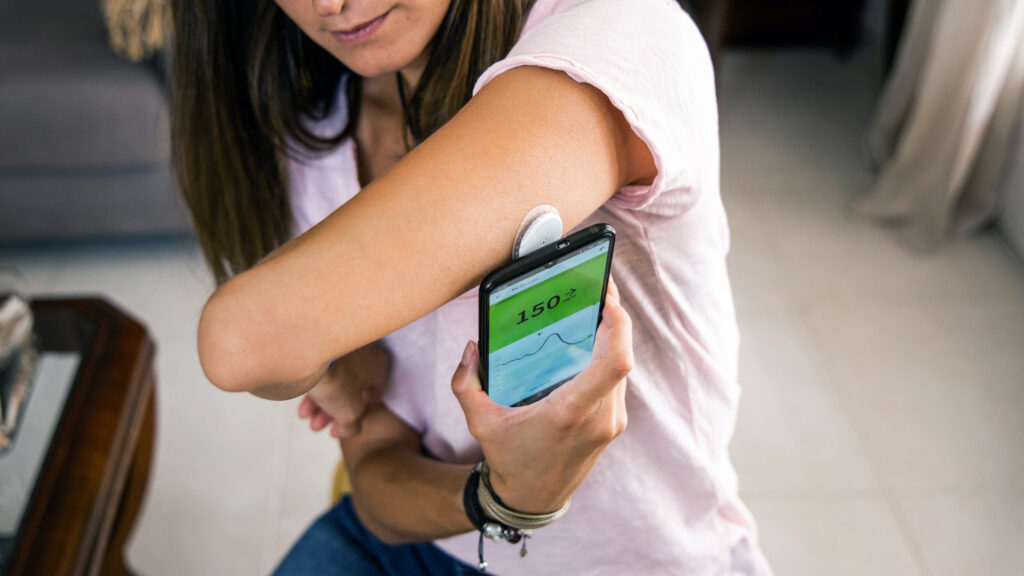Does Monitoring Glucose Levels on a Minutely Basis Represent a Valuable Trend?
Image of a person wearing a continuous glucose monitor (CGM) on their arm
Forget counting steps and analyzing sleep cycles – the latest health tech craze has healthy folks obsessing over their glucose levels. Continuous glucose monitors (CGMs), once solely for diabetics, are now strapped to the arms of athletes, biohackers, and everyday health enthusiasts, all eager to unlock the secrets of their internal sugar rollercoaster.
Tip: Please fill out the form if you or a friend would like more information on glucose monitoring devices for glucose Level management.
But before you shell out hundreds for a tiny sensor and a subscription to your body’s glucose data, pump the brakes. Experts are skeptical about the real-world benefits for healthy individuals, raising questions about the hype and the hefty price tag.
So, what’s the deal with CGMs?
These thimble-sized marvels use a tiny sensor inserted under the skin to continuously monitor glucose levels in the interstitial fluid – the gooey space between your cells. Think of it as a real-time spy mission into your sugar metabolism, sending updates to your phone every few minutes.
Image of a CGM sensor being inserted under the skin
For diabetics, CGMs are game-changers. They provide crucial data for managing insulin, preventing life-threatening highs and lows, and improving overall health. But for healthy folks, the picture gets murkier.
Read Guide about Wegovy Dosage Guide: The Best Way For Weight Loss
Here’s the rub:
- The “stable glucose levels myth”: Healthy glucose levels naturally fluctuates. Pizza spikes it, a brisk walk brings it down. CGMs might reveal these normal ups and downs, potentially triggering unnecessary anxiety and obsession.
Image of a graph showing normal glucose levels fluctuations
-
Limited “normal” data: We know what diabetes looks like, but defining “normal” glucose levels for healthy individuals is still a work in progress. Comparing your data to a moving target isn’t exactly helpful.
-
Cost vs. benefit: CGMs aren’t cheap. Sensors need replacing every two weeks, setting you back thousands a year. Is that worth the potential for a few data-driven tweaks to your already healthy lifestyle?
Experts like dietitian Abby Langer urge caution: “Focus on the basics – balanced diet, movement, sleep, joy. That’s the recipe for health, not a gadget on your arm.”
Instead of chasing biohacks, consider this:
-
Listen to your body: Cravings, energy levels, and overall well-being are often better indicators of health than a glucose graph.
-
Consult a doctor: If you have concerns about your glucose levels, a healthcare professional can offer personalized guidance, tests, and strategies.
-
Keep it simple: A good old-fashioned finger prick glucose meter can provide occasional checks when needed, at a fraction of the cost.
Must Read CGMs in noncritical care hospitals optimizes glycemic control
Image of a person using a finger prick glucose meter
The bottom line: CGMs are valuable tools for diabetics, but for healthy individuals, the jury’s still out. Before jumping on the bandwagon, ask yourself: is chasing minute-by-minute glucose data worth the cost, potential anxiety, and unclear benefits? Perhaps focusing on the bigger picture – a healthy lifestyle and a good doctor-patient relationship – is the sweeter deal after all.
Also, read about Sugar Alert! Warning Signs of Diabetes
Remember, biohacking isn’t a one-size-fits-all recipe. Choose the tech that empowers you, not one that adds stress to your plate.
Now, go forth and conquer your health journey, but do it on your own terms, not the algorithm’s.


